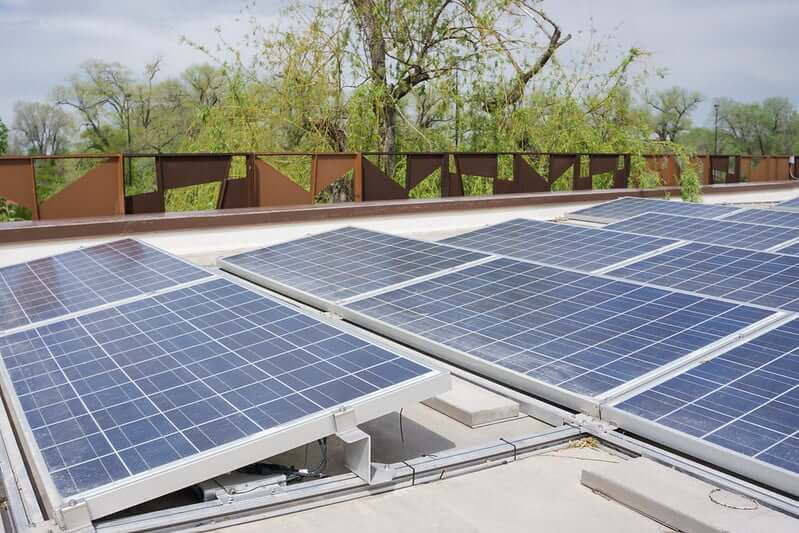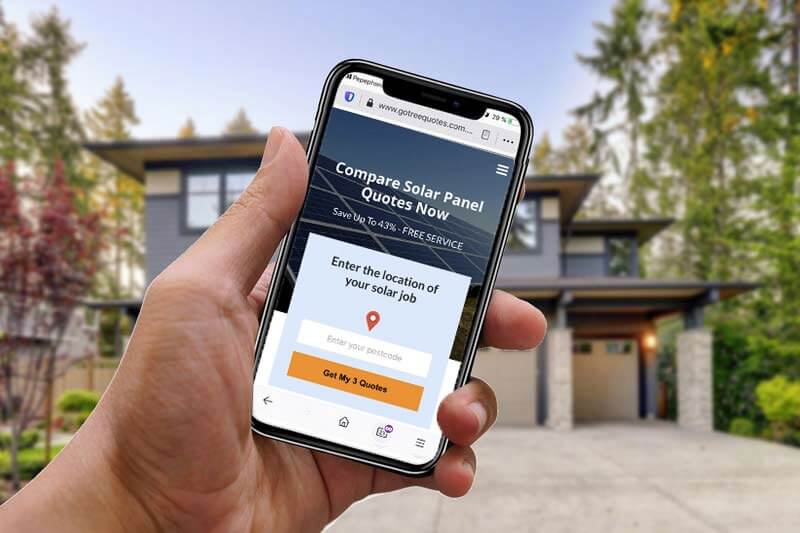Home Solar Panels For Renters
Solar Panels For Renters: How It Works + Costs in 2025
By
Ben McInerney
| on January 21, 2025
In Australia, 3 million homes 1 have fitted solar panels to their abodes. Is it possible for the significant number of households that are renting to also enjoy the advantages of solar energy?
Renters can also have solar panels installed in the homes they live in. However, they have to wait for the landlord to install it. If they want to install the panels themselves, they have to agree on how to own the panels. They can also use community solar or purchase portable solar panels.
Solar power ensures that renters can also enjoy low electricity bills in their homes. Let us look further at how a tenant can get solar.

 3 Sources
3 Sources

Tracy Aviary | Wikimedia Commons | CC BY-SA 2.0
Table of Contents
ToggleScenarios for landlord installed solar panels
Before or upon installation of solar panels, landlords and tenants must discuss how the tenant will pay for the solar power. Solar panel installation benefits the person registered on the electricity account. Hence the need for agreement. Here are some of the common scenarios where landlords have installed solar in rental properties.- The electricity account is maintained in the tenant’s name. The tenant earns a feed-in tariff for excess power sent to the grid, which helps offset power costs.
- The landlord’s name is on the bill. The landlord will pay the electricity bill and charge the tenant as part of their rent.
- The landlord keeps the electricity account in their name. They will pay the electricity bill. They will then charge tenants the full amount of the bill less the credits from the feed-in tariff.
- The landlord keeps the electricity bill in their name. They will pay the electricity bill, less the credits earned, and they will then charge the tenant the full bill. It allows them to cover the costs of solar panel installation. This is unfair to the tenant since solar should reduce the electricity bill.
Community solar
Community solar2 is a popular way for renters to access solar power. It is a project that provides solar to those who cannot install solar panels on their roof. A community solar project involves installing solar panels in an open field near the homes of the beneficiaries of the project. It is known as a solar farm. Members contribute a specified amount of money to support the project every month instead of paying an electricity bill. The power generated from these solar panels enables the members of the project to get credits on their electricity bills.How much does community solar cost?
Depending on where you live, members of the community solar project contribute a minimum of $500 to a maximum of $10,000 to set up the solar farm. Users also maintain a monthly contribution to run the project.Community Solar vs. Rooftop Solar
Community solar and rooftop solar are both viable options for individuals and communities looking to embrace renewable energy, but they differ in several key aspects. Community solar involves shared solar arrays installed in a centralized location, allowing multiple participants to benefit from solar energy without needing rooftop access. This model is ideal for renters, homeowners with shaded roofs, or those unable to afford upfront installation costs. In contrast, rooftop solar entails installing solar panels directly on individual roofs, providing homeowners with control over their energy production and potential savings on utility bills. While community solar promotes accessibility and inclusivity, rooftop solar offers greater autonomy and potential for customization to meet specific energy needs. Both options contribute to reducing carbon emissions and fostering sustainable energy practices, offering flexibility and choice to consumers seeking greener alternatives.Benefits of community solar
- Improves the carbon footprint of the community. More people generate and use renewable energy instead of relying on fossil fuels.
- Lowers electricity bills.
- Allows renters access to solar energy
- Sustainable energy project.
- Job creation.
- Benefits the community.
- Build connections within society.
Choosing the Best Community Solar Model
Deciding on the optimal community solar model hinges on your specific energy requirements and personal preferences. For instance, if you value direct control, the ownership model may suit you best. Conversely, if you prefer a hassle-free approach and wish to support renewable energy without initial expenses, the subscription model might be more appealing. To make an informed decision, evaluate your financial objectives and energy goals.Ownership Model
Community solar ownership entails direct ownership of a portion of the solar energy system. Participants make an initial investment, granting them control over their share of the project and eligibility for benefits such as tax credits. This model is ideal for those aiming for long-term electricity bill savings and a sense of ownership. However, it necessitates the ability to make an upfront financial commitment to the solar installation.Subscription Model
In the community solar subscription model, individuals can access clean and renewable energy without upfront costs or system ownership. Subscribers receive credits towards their electricity bills based on the energy generated by their share of the system. Opting for the subscription model allows individuals to reap the benefits of solar power without the responsibilities of system maintenance and management.Portable solar panels
Renters can also use portable solar panels to power their homes. Normally, they are used outdoors when camping. Portable solar panels can be installed on rooftops like the others. They capture sunlight, convert it to electricity and store it in suitable size batteries. You can also add an inverter to the portable panel system to make the power suitable for use at home. Portable solar panels are easy to set up when camping or at home. They need little maintenance and are easy to use, and durable.How much do portable solar panels cost?
There are several brands of portable solar panels you can buy. Most people who purchase these solar panels use them for camping. Depending on the size of the panels, you will pay $500 to $1,0003 for portable solar panels.Pros of portable solar panels
- Lightweight
- Easy to set up.
- Easy to fold. Renters using portable solar panels can uninstall them quickly, fold them and store them in small spaces.
Renter and landlord co-contribution
Renters and their landlords can agree to co-contribute and purchase a solar system for their home. In this case, tenants contribute to the purchase of the solar panels to be installed. It allows the tenant to have a low electricity bill. However, if the landlord took a loan to purchase the solar panel, the tenant must help the landlord pay the loan. There are various ways a landlord can charge renters for solar discussed here.Benefits of installing solar panels in rental property
High-value tenants
When you install solar panels on your rental property, you are likely to attract high-value tenants. Tenants living in rental properties installed with solar panels are more willing to pay higher rents in exchange for the low electricity bills. Additionally, high-value tenants will know that they have a lower carbon footprint when they live in a rental property installed with solar panels. Tenants in a solar-installed property are also likely to stay on longer.Tax credit
As a landlord, you can claim tax deductions when you install solar panels on an investment property. Solar panel installation can be seen as capital expenditure for the improvement of investment property. You can claim the deductions for as long as you have solar panels on your property. Tax deductions lower the expenses on your property and increase the money or profit you make.Increase the value of the property
If you decide to sell your investment property that is installed with solar panels, you are likely to get a higher price for it. The larger the solar system installed on the property, the higher the price you can fetch for your property.Point of attraction
When tenants are looking for a property to rent, they find that many are all the same. Rental properties with solar panels installed have a point of difference from other properties. It makes them more attractive to potential tenants.Tenants enjoy lower electricity bills
Installing solar on tenants’ homes ensures that they can enjoy lower electricity costs. The lower costs ensure that your tenants will stay longer in your property instead of moving to another with higher electricity bills.Factors to consider when choosing solar panels for your rental property
- Solar panel cost. There are many solar panel brands in the market. Each brand has its price and quality. Extensive market research ensures that you get the right panels for your budget and needs.
- Size of the property. The larger the rental, the larger the solar system you need. Usually, larger homes have more electricity consumption.
- Size and design of the roof. If you have a large roof, it can hold more solar panels of different sizes. The more panels installed, the larger your solar system.
- Power consumption. The higher the consumption, the larger the size of the panels needed.
- Your installer. Hire a CEC-accredited installer. You will get rebates on installation and ensure that your solar panels are correctly installed. Also, get at least three quotes from an accredited installer before you choose or hire.
- Durability. Solar panels last up to 25 years. Check the warranty and ensure that it indicates how long the solar panel is likely to last. Purchase only solar panels with a guaranteed long life.
Solar panel assistance for Victoria landlords who want to install solar panels in rental property
Victoria has a landlord assistance program. To be eligible, you must:- Your rental property must be currently occupied.
- The income of your tenants’ household income should be less than $180,000.
- Your property is worth up to $3 million.
- It does not have existing solar panels
- The property has not received a solar rebate before.
Can landlords in other regions get assistance to install solar panels on rental property
Depending on where you live, landlords can access interest-free or low-interest loans to purchase and install solar panels in rental properties. These are available in QLD, NSW, and VIC. Additionally, properties that have not had solar panels installed can enjoy a rebate on the purchase and installation of the solar panels. Feed-in tariffs from electricity retailers for exporting solar power to the grid also help lower the cost of solar power installation and use.Hire a pro to install your solar system
GoSolarQuotes.com.au matches you with three local solar installers voted #1 by previous users in your area. “No hard sales, just friendly advice, and great prices”- Scroll up to the top of the page and enter your postcode in the blue form.
- Answer a few simple questions about your solar needs.
- Your solar job details are forwarded to the closest three solar installers, all voted best priced, by previous homeowners near you.
 3 Sources
3 Sources
- Australian government clean energy regulator, (2021), Australia reaches the 3 million solar milestone. Accessed on: 15th April 2024, https://cer.gov.au/australia-reaches-3-million-solar-milestone#:~:text=We%20have%20known%20for%20a,have%20installed%20solar%20in%20Australia.
- Bailey Benning field, (2024), What Is Community Solar? Plus, The Major Pros And Cons, Accessed on: 15th April 2024, https://www.forbes.com/home-improvement/solar/what-is-community-solar/#:~:text=In%20the%20community%20solar%20subscription,share%20of%20the%20system%20generates.
- Catherine Lane , (2024), What is a solar tracker and is it worth the investment? Accessed on: 15th April 2024, https://www.solarreviews.com/blog/are-solar-axis-trackers-worth-the-additional-investment
Compare Solar Panel Quotes
Table of Contents
Toggle









